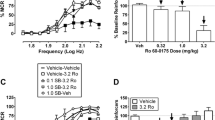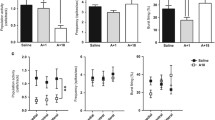Abstract
The effects of serotonergic manipulations on the escape interference engendered by exposure to inescapable shock were assessed. Consistent with the view that the behavioral interference was related to reductions of serotonin (5-HT), treatment with the 5-HT receptor blocker methysergide mimicked the effects of inescapable shock in that it increased escape latencies. Conversely, acute treatment with a moderate dose of the 5-HT releasing agent p-chloroamphetamine (PCA) effectively antagonized the escape interference ordinarily provoked by inescapable shock. The effects of PCA were behaviorally distinguishable from the previously observed effects of catecholamine stimulants. Whereas catecholamine stimulants applied prior to either inescapable shock or escape testing eliminated the interference, PCA antagonized the behavioral disruption only if it was administered before testing. It is suggested that catecholamine alterations may be fundamental in the provocation of the interference, whereas 5-HT variations may contribute to the expression of the behavioral disturbance.
Similar content being viewed by others
References
Anisman H (1984) Vulnerability to depression: Contribution of stress. In: Post RM, Ballenger JC (eds) Neurobiology of mood disorders. Williams and Wilkins, Baltimore
Anisman H, de Catanzaro D, Remington G (1978) Escape performance following exposure to inescapable shock: Deficits in motor response maintenance. J Exp Psychol Anim Behav Proc 4:197–218
Anisman H, Irwin J, Sklar LS (1979a) Deficits of escape performance following catecholamine depletion: Implications for behavioral deficits induced by uncontrollable stress. Psychopharmacology 64:163–170
Anisman H, Remington G, Sklar LS (1979b) Effects of inescapable shock on subsequent escape performance: catecholaminergic and cholinergic mediation of response initiation and maintenance. Psychopharmacology 61:107–124
Anisman H, Pizzino A, Sklar LS (1980) Coping with stress, norepinephrine depletion and espace performance. Brain Res 191:583–588
Anisman H, Glazier S, Sklar LS (1981) Cholinergic influences on escape deficits produced by uncontrollable stress. Psychopharmacology 74:81–87
Blanc G, Herve D, Simon H, Lisoprawski A, Glowinski J, Tassin JP (1980) Response to stress of mesocortical-frontal dopaminergic neurons after long-term isolation. Nature 284:265–276
Brown L, Rosellini RA, Samuels OB, Riley EP (1982) Evidence for a serotonergic mechanism of the learned helplessness phenomenon. Pharmacol Biochem Behav 17:877–883
Costa E, Naimzada K, Revuelta A (1971) Effect of phenmetrazine, aminorex and (+)-p-chloroamphetamine on the motor activity and turnover rate of brain catecholamines. Br J Pharmacol 43:570–579
Fuxe K, Butcher LL, Engel J (1971) dl-5-Hydroxytryptophan induced changes in central monoamine neurons after peripheral decarboxylase inhibition. J Pharm Pharmacol 23:420–424
Hellhammer D (1983) Learned helplessness — An animal model revisited. In: Angst J (ed) The origins of depression: current concepts and approaches. Springer, New York
Maier SF, Seligman MEP (1976) Learned helplessness: Theory and Evidence. J Exp Psychol: Gen 105:3–46
Messing RB, Pettibone DJ, Kaufman N, Lytle LD (1978) Behavioral effects of serotonin neurotoxins: An overview. Ann NY Acad Sci 305:480–496
Ogren S-O (1982) Forebrain serotonin and avoidance learning: Behavioral and biochemical studies on the acute effect of p-chloroamphetamine on one-way avoidance in the male rat. Pharmacol Biochem Behav 16:881–895
Petty F, Sherman AD (1982) A neurochemical differentiation between exposure to stress and the development of learned helplessness. Drug Dev Res 2:43–45
Ross SB (1976) Antagonism of the acute and long-term biochemical effects of 4-chloroamphetamine on the 5-HT neurones in the rat brain by inhibition of the 5-hydroxytryptamine uptake. Acta Pharmacol Toxicol 39:456–476
Sanders-Bush E, Steranka L (1978) Immediate and long-term effects of p-chloroamphetamine on brain amines. Ann NY Acad Sci 305:208–221
Sherman AD, Petty F (1980) Neurochemical basis of the action of antidepressants on learned helplessness. Behav Neurol Biol 30:119–134
Thierry AM, Tassin JP, Blanc G, Glowinski J (1976) Selective activation of the mesocortical DA system by stress. Nature 263:242–244
Weiss JM, Glazer HI, Pohorecky LA (1976) Coping behavior and neurochemical changes: An alternative explanation for the original “Learned Helplessness” experiments. In: Serban G, Kling A (eds) Animal models in human psychobiology. Plenum Press, New York
Weiss JM, Goodman PA, Losito BG, Corrigan S, Charry JM, Bailey WH (1981) Behavioral depression produced by an uncontrollable stressor: Relationship to norepinephrine, dopamine, and serotonin levels in various regions of rat brain. Brain Res Rev 3:167–205
Zajaczkowska MN (1975) Actylcholine content in the central and peripheral nervous system and its synthesis in the rat brain during stress and post stress exhaustion. Acta Physiol Pol 26:493–497
Author information
Authors and Affiliations
Rights and permissions
About this article
Cite this article
Hamilton, M.E., Zacharko, R.M. & Anisman, H. Influence of p-chloroamphetamine and methysergide on the escape deficits provoked by inescapable shock. Psychopharmacology 90, 203–206 (1986). https://doi.org/10.1007/BF00181242
Received:
Revised:
Issue Date:
DOI: https://doi.org/10.1007/BF00181242




